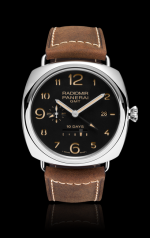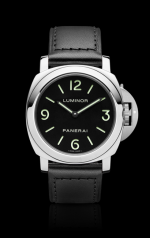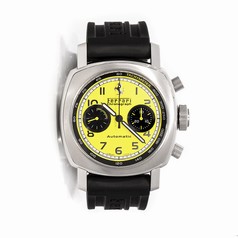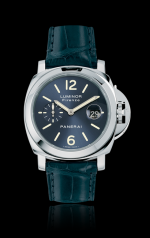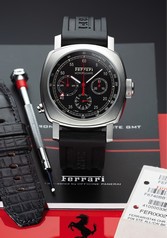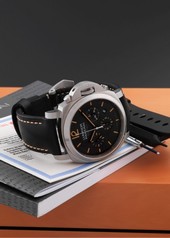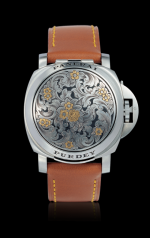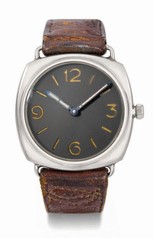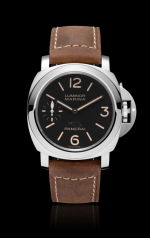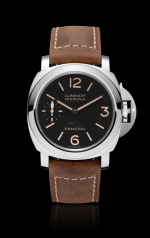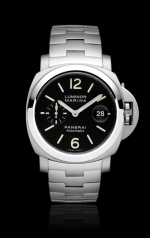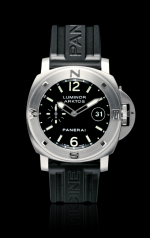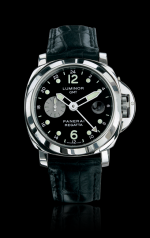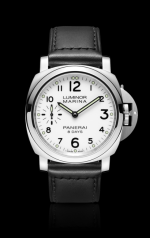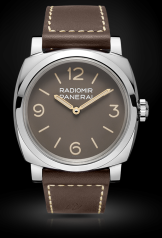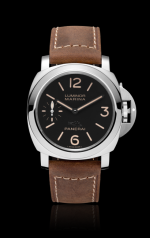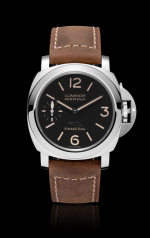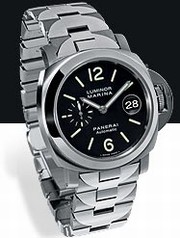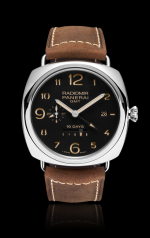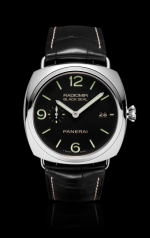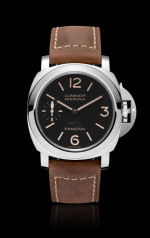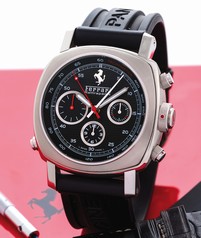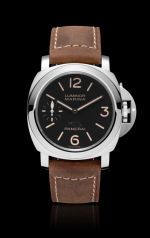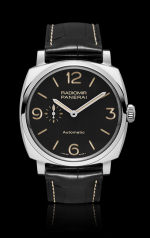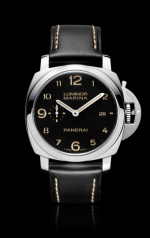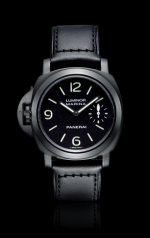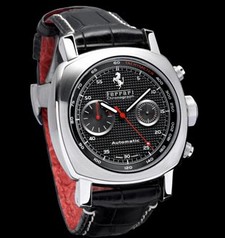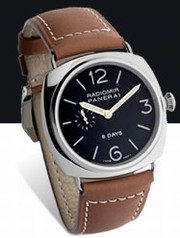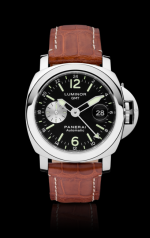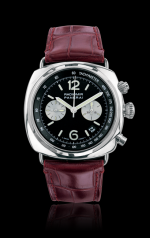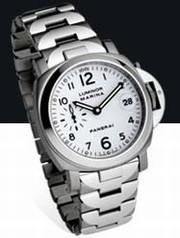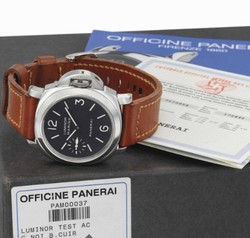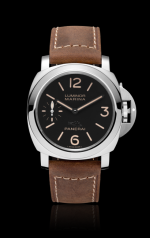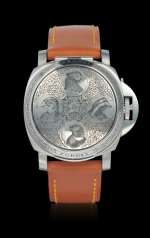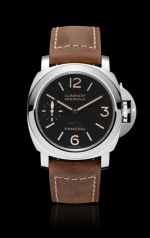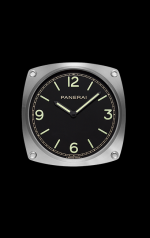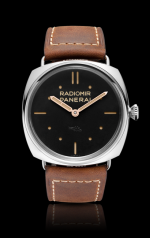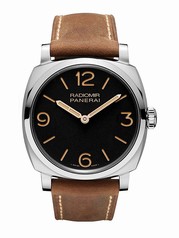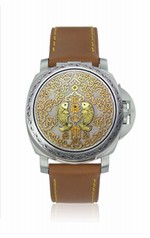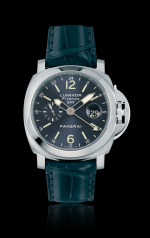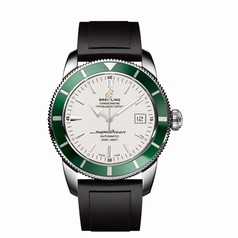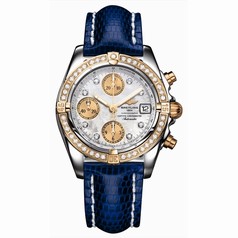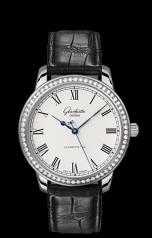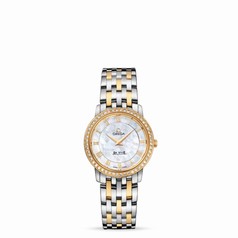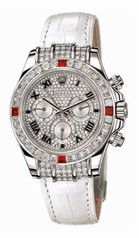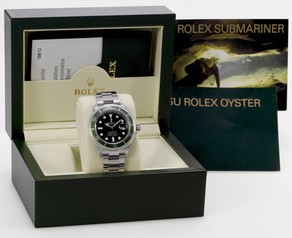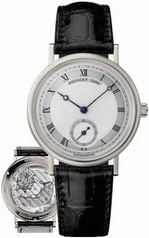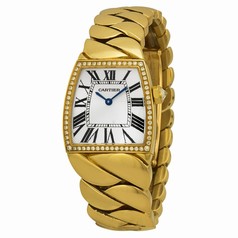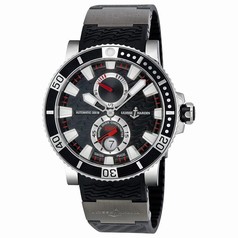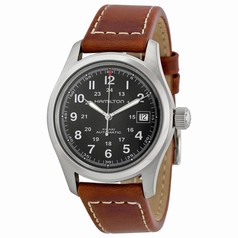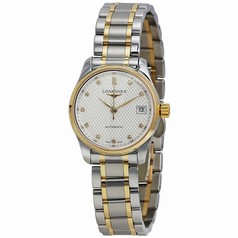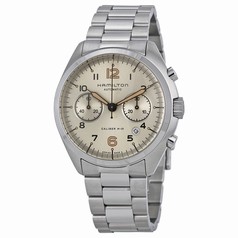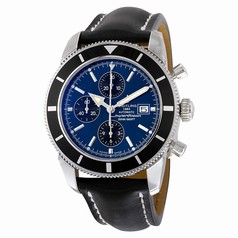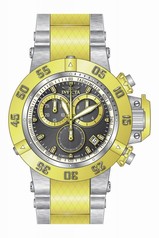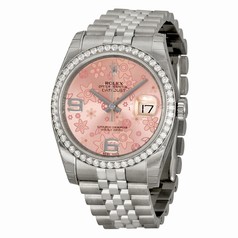Panerai - Radiomir 3 Days Acciaio/Oro Rosso - 42mm
With its timeless design and the sophisticated technical solutions created by the new Manufacture in Neuchâtel, the Radiomir 1940 is the main focus of the new Panerai collection presented at Watches & Wonders 2015.
It is the calibre P.1000, a new hand-wound movement with a power reserve of three days, which powers the new Radiomir 1940 3 Days, available in steel or red gold with
a diameter of 42 mm. Unmistakably Panerai in their design and respect for the company's historic characteristics, the two new models have sizes and features which make them the ideal choice for all enthusiasts looking for a watch with pure lines but a b personality, versatile and suitable to every situation.
The new P.1000 calibre is entirely made in the Panerai manufacture in Neuchatel. The movement features a large brush-finished bridge covering the major part of the wheelwork and a bridge with two supports firmly holding the balance, which oscillates at a frequency of 4 Hz (28,800 vibrations per hour). Thanks to the two spring barrels connected in series, the calibre has a three days power reserve, a requirement which has been part of the identity of the brand since the 1940s, when the Florentine watchmakers Panerai decided to use Angelus calibres with a power reserve of eight days for the watches supplied to the Italian Navy. Its commandos had to be able to count on an instrument with reliable timekeeping which would not be subject to wear or leaking as a result of frequent rewinding.
The new Radiomir 1940 3 Days also has the system for stopping the balance which operates in conjunction with the device for zeroing the seconds hand: when the winding crown is pulled out, the balance wheel stops and the seconds hand, rotating in the classic subsidiary dial at 9 o'clock, is moved back to zero, so that the watch can be synchronised exactly with the reference time signal.
The case is water-resistant to 10 bar (a depth of about 100 metres) in the polished AISI 316L stainless steel version and to 5 bar (about 50 metres) in the gold version. The latter is made of 5NPT red gold, the special gold alloy used by Panerai, which has a high percentage of copper, as well as a small amount of platinum which helps to prevent the precious metal oxidising.
The sapphire crystal of the porthole on the back of the new Radiomir 1940 3 Days enables the construction and finish of the P.1000 movement to be admired while the polished bezel frames the classic Panerai black dial, with large bar markers and figures. In the steel model (PAM00574) the alligator strap is coordinated with the light green of the Super-LumiNova, while the model in red gold (PAM00575) is supplied with a black alligator strap.
Why not...? - The Panerai PAM 590
We are in Egypt, 600 years before Christ.
The Pharaoh's wise men have just developed a new instrument for reading the time. It is called the Merkhet. Its original construction allows it to read the time even after sunset. With this invention, man can start to tell the time even in the black of night. And this will allow him to improve the precision of time reading.
Nowadays this story seems outmoded or confined to archaeology books. There is light everywhere and the time can be read in any conditions. Even at night, the light shines…
But things have not always been so. Not so long ago, in fact, the ability to read the dial of a watch was of crucial importance. And, as is so often the case, it was war that created this need.
On the night of 20th December 1914, the French Farman MF 11 were the first bombers to fly at night. The ability to read flight instruments in complete darkness thus became a strategic priority.
From 1917, the American Defense Department decided to order luminescent watches from the US Radium Corporation, which used radium paint for the luminescence. History recalls above all the struggle of the "radium girls", who spent their days painting watch dials with radioactive substances, with the health effects that we can imagine.
But at the time, this production was strategic… and it remained so for a long time.
At the dawn of the second world war, such instruments that were readable at night were no longer needed just in the air. Night could also appear in the middle of the day - you just had to dive under water.
We now move to Italy, where a few men understood that underwater combat could offer a precious advantage in the case of conflict. They followed the example of two of their predecessors, Major Rossetti and Lieutenant Paolucci, who became the first combat swimmers in history, when they sunk an Austro-Hungarian cruiser in the port of Pola in November 1918.
Inspired by this feat, their comrades wanted to dive discreetly, swim towards their targets, destroy them and then disappear. They became the first combat swimmers of the 10th MAS flotilla.
In order to operate at night and underwater, the members of the MAS flotilla needed equipment that was both reliable yet innovative, including genuine diver's watches that were both water resistant and legible. And it was this latter aspect that needed the most work. One of the officers in the flotilla heard about a watch workshop in Florence. He visited it and met Guido Panerai. Together, they decided to develop a watch that would meet the requirements for future operations by the Italian swimmers.
Once again, radium was called to the rescue. Panerai developed a water resistant watch with two superimposed dials: one was hollowed out with large 12, 3, 6 and 9 numerals and the other was covered with radium. They were fitted into an oversized case that was 47mm in diameter and housed a Rolex movement.
The Radiomir was born.
This is where the story starts. Italy's combat divers started operations. Their exploits inspired navies all over the world. And they wore new versions of the Radiomir. By the end of the conflict, Panerai had produced just over a thousand watches, but this remained a military secret for years to come.
In order to keep its market share, the Florentine brand improved its Radiomir models and looked to other countries that called upon the services of former combat divers from Italy. But the technical specifications did not change: legibility and water resistance.
The dangerous radium was soon replaced by a new substance based on tritium: luminor. The water resistance of the newer diver's watches was also improved by a new crown protecting bridge, which is today affectionately known among fans as the "bottle opener".
But it is once again an aspect of light that gave the new watch its name: the Luminor.
Still today, the Luminor and Radiomir models dominate the Panerai catalogue. They are no longer military secrets but they still keep their unmistakable DNA, a mixture of industrial design, operational simplicity and Latin charm.
Luminor or Radiomir. The choice appears simple. Yet it is decidedly complicated. In the end, I opted for a Luminor that is particularly dear to my heart: the PAM 590. It is the link between the past and the present, bearing a seal that is famous in the brand's history, and was launched this year as a limited edition. It is the embodiment of what I think a true Panerai should be.
Why Panerai ?
The Luminor and Radiomir are the two emblematic models of the brand, which was relaunched in 1993 and incorporated into the Vendôme group in 1997 (which later became the Richemont Group). Officine Panerai has since experienced an astonishing rise to fame.
Even though its history is not as long as that of many of the famous Swiss brands, Officine Panerai has managed to exploit it in an almost unique way, using the techniques of Hollywood to build up its muscled up Radiomir and Luminor models in the style of the Expendables, order its collections like sequels or even prequels and grab the attention of an appreciative and particularly expert audience by developing its models in very small steps.
The brand has not only imposed its unique style, it has also liberated wrists by daring to offer 44mm diameter cases from the start of the 1990s, then relaunching the original 47mm cases at a time when 39mm was the norm.
Furthermore, Officine Panerai probably invented the concept of special editions and still today manages to generate both excitement and frustration among fans and yet still be forgiven! Although the concept is now found in overabundance among its competitors, whose initiatives are not always successful, the Officine can delve into its history - and the abundance of prototypes and variants in its production - to surprise and constantly nurture the legend.
The Panerai Luminor PAM 590: From the US with love!
The first version of the Luminor dates back to 1950. At the time, this diver's watch had a diameter of 47mm and a case that was rounder than that of the current 44mm Luminor models. In order to highlight the difference, a few years ago Panerai produced a version similar to the original model: the PAM 372.
But let's get back to our contemporary Luminor. It means a lot in the recent history of the Officine, because Panerai re-entered the watch market with a similar model in 1993. Before 1997 and the acquisition by the Vendôme Group, which later became Richemont, Panerai produced several versions of its Luminor with a concession to its predecessor: its size shrunk from 47mm to 44mm.
Offering a 44mm watch in 1993 was already very audacious. Panerai would wait a few more years before re-issuing its legendary 47mm model.
In order to lure future customers, the teams at Panerai decided to recreate the Luminor. The task was entrusted to Alessandro Bettarini, who designed a new case that was more angular than the original and had slightly reduced proportions. The success of this new version was such that Paneristi (as fans of the brand are known) call it the Bettarini.
The Bettarini is still listed in the Panerai catalogue but at the SIHH in 2014 the brand presented a new version, still at 44mm diameter, but with a more refined profile. The PAM 590 uses this new case.
Another major change is the movement. Since 1993, Panerai had been using Unitas movements in its Luminor models, which fitted well with its image as an assembler of tool watches. But, following its competitors, the brand presented its first "in house" movement, the P2002, in 2005. A long series of new movements followed until the hand-wound P5000 movement was launched in 2014, with an eight-day power reserve. Thinner than the Unitas, this movement allowed the Bettarini case to shed some weight.
It is the impressive power reserve that makes the Panerai PAM 590 so interesting. It bears the inscription "8 giorni brevettato" on the dial, which first appeared in 1950 on a Luminor Submersible produced for the Egyptian navy. At the time, the watch was fitted with an Angelus calibre.
The "8 Giorni" name stuck and still gets collectors salivating. Panerai has only launched a few models with this logo on the dial. The PAM 590 is one of them, which gives it even more charm.
The dial hides another interesting feature of the 590. Like all Panerais it is simple and loyal to the principles of legibility. The 9 is replaced by a small seconds counter. But if you look closer you will see that the colour of the hour markers is different from the colour of the "Luminor Panerai" text or the "8 Giorni" logo. The hour markers are orange, the text is white.
In Panerai culture this is known as a "non-matching" dial. It is an allusion to the first watches of the pre-Vendôme period (before the acquisition by Richemont), on which some white luminous hour markers would quickly change colour on exposure to the sun, creating a difference in colour between the (non-luminescent) inscriptions on the dial and the hour markers. What was originally a quality issue thus became a genuine Holy Grail. Some dials were replaced but other owners kept their watches as they were, thus creating a buzz about "non matching" dials that now makes them sought after because they are original.
The Panerai PAM 590 takes on this characteristic and therefore has a dial inspired by vintage models. Another reason to fall for it.
In summary, our Luminor has a "Bettarini" case, a "non matching" dial and an "8 Giorni" inscription.
At the start of this review, these terms may not have got your attention. But now that you have become Paneristi, you know why this Panerai PAM 590 is so special.
And if I add that in 2014 it is only available in the USA, I create both frustration and expectation.
Welcome to the world of Panerai!
What does the devil's advocate think?
A Panerai is recognisable, easily identifiable. This is both its strength and its weakness. The uninitiated will quickly say "OK, it's a Panerai". But the strength of the brand is in the subtlety of the changes it has made to its models from one year to the next. And this subtlety is sometimes… too subtle! You need time to appreciate the difference in colour of the hour markers, the orange of some numerals compared with the sandy yellow of others. Or the shape of a hand that recalls a particular model of 1942, compared with one from 1943! And there are numerous other examples.
A Panerai, therefore, is not just a watch. It is an object that you have to get to know, and that takes time. It will help you to get to grips with a phrase that angers any enlightened fan: "they are all the same!".
What image does the wearer of this Panerai project?
A Panerai is a "tool watch", an instrument for work invented to serve a particular purpose. It was born to be functional and effective, not to please. And that is precisely why it does please!
If the wearer of this PAM 590 is able to explain the distinguishing features of this model compared with another Luminor, he will already have come a long way and will be considered an expert rather than someone who has simply given in to a particular fashion.
Another point that is specific to Panerai watches: their ability to "accept" all kinds of leather straps. The Luminor is particularly versatile in this regard and has helped to build up a "strap culture" that is specific to the brand.
So if you really want to show that you are an aficionado, nothing could be simpler: forget about the strap supplied with the Panerai 590. It's not that it's ugly in any way, just that you should not keep it! That's the way it is. Choose a 74 instead, which will suit it very well.
You don't know what a 74 is?
Then you still have some ground to cover in your Paneristi education!
It's up to you to find the answer…
Panerai - Luminor 1950 composite 3 days - 47 mm
Officine Panerai presents a new Special Edition in Panerai Composite, the synthetic composite used in haute horlogerie for the first time by Officine Panerai and produced by an electro-chemical process of transforming aluminium. The new Luminor Composite 1950 3 Days - 47mm combines the characteristics and performance of this material, exceptional for its lightness, strength and durability, with the new hand-wound P.3000 calibre, entirely designed and produced in the Officine Panerai manufacture in Neuchâtel.
The Luminor 1950 case in Panerai Composite is 47 mm in diameter, a classic size for Panerai watches, and it has a matt brown appearance of great evenness. Made of the same material are the bridge protecting the winding crown with the classic clamping lever and the round bezel which surrounds the sapphire crystal with anti-reflective treatment. Water-resistant to 100 metres, the case has the polished crystal back which enables the movement to be seen.The sandwich dial too is dark brown and stripped to essentials with the characteristic small seconds dial at 9 o'clock. The dial is of sandwich construction, being formed of two thin metal discs, the upper one of which is perforated to allow the luminous substance placed between them (Super-LumiNova®) to be seen. The hands are also covered with the same luminous substance, in a special ecru colour so as to reproduce the vintage appearance of the dials of the period.
The movement used in the Luminor Composite 1950 3 Days - 47mmis the manufacture P.3000 calibre. With a diameter of 16½ lignes and hand-wound, the movement has a structure with large bridges, comparable to plates, while from the technical point of view it has two spring barrels, ensuring a power reserve of 72 hours (three days), and a large-diameter balance wheel with adjusting screws.Identified by the reference PAM00375, the new Luminor Composite 1950 3 Days - 47mm is produced in a unique numbered edition of 2,000 examples and it is supplied with a leather strap, closed by a buckle made of Panerai Composite.
Movement: Hand-wound mechanical, Panerai P.3000/1 calibre, executed entirely by Panerai, 16½ lignes, 5.3 mm thick, 21 jewels, Glucydur® balance, 21,600 alternations/hour. Incabloc® anti-shock device. Power reserve 3 days, two barrels. 160 components.Functions: Hours, minutes, small seconds.Case: Diameter 47 mm, brown Panerai Composite.Bezel: Brown Panerai Composite, integrated into the case.Back: See-through burnished sapphire crystal.Device protecting the crown: (protected as a Trademark) Brown Panerai Composite.Dial: Brown with luminous Arabic numerals and hour markers. Small seconds at 9 o'clock.Crystal: Sapphire, made from corundum, 2mm thick. Anti-reflective coating.Water-resistance: 10 bar (~100 metres).Strap: PANERAI personalised leather strap and large-size Panerai Composite buckle. Supplied with a second interchangeable strap and a steel screwdriver.Reference: PAM00375.
Calibre P.3000Entirely designed, developed and produced in the Officine Panerai Manufacture in Neuchâtel, the hand-wound P.3000 calibre presents the main characteristics of the Panerai movements both in terms of structure and in terms of performance, robustness, accuracy and its long power reserve.
The thickness of the calibre P.3000 is 5.3 mm and the diameter is 16½ lignes, a substantial size which traces its origins from that of the movements which were fitted to the historic Panerai models. The calibre is immediately recognisable by its construction, which is similar to that of a three-quarter plate movement: a large bridge, next to another smaller one, covers the majority of the mechanical parts and it is fixed to the bottom plate by a series of screws of substantial thickness, thus forming a particularly rigid structure.
The movement has 21 jewels and it uses two spring barrels connected in series. Such an arrangement enables long, thin springs to be used, which ensures the delivery of a more even force and also does so over a longer period of time, with a power reserve of 3 days. The balance wheel is unusually large (13.2 mm) and it is the variable inertia type, with four adjusting screws arranged externally round the ring, so that the rate can be regulated without it being necessary to remove the whole assembly. Supported by a bridge with twin supports - a fixing much safer and more stable compared to the cantilevered single bridge - the balance wheel oscillates at a frequency of 3 Hz, equivalent to 21,600 alternations per hour. It is fitted with an Incabloc® antishock device and is free-sprung, so there is no regulating lever.
With brush-finished bridges and chamfered angles - that is, with the angles smoothed and polished - the P.3000 calibre is also fitted with the device for the rapid adjustment of the time: a star wheel with 12 points and a small spring clutch enable the hour hand to be moved one hour at a time, without interfering with the movement of the minute hand or the operation of the watch.
Functions
- Hours, minutes, small seconds
Technical specifications
- Hand-wound
- Power reserve 3 days
- 160 components
- 21 jewels.
- 16½ lignes in diameter
- 5.3 mm thick
- Two spring barrels
- Frequency of oscillation 3 Hz
- Incabloc® anti-shock device

